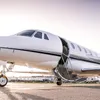Global aviation: Challenges, opportunities, and the roadmap to recovery
The new normal for airlines would mean nimbler teams, rethinking intelligence, and redefining revenue generation. What challenges does the aviation industry need to overcome to realise this change?

According to OAG, global flights scheduled this April were on average 80 percent lower compared to 2019. Airlines across the world witnessed a nose-dive due to the pandemic-induced-lockdowns.
Realising the prolonged impact COVID-19 is bound to inflict until an antidote is developed, many countries are trying to restore normalcy with the virus in the backdrop. And, as WHO rightly puts it, "We have all got to learn to live with this virus."
The new normal for airlines would fundamentally mean that commercial teams, unlike earlier, need to be nimbler, revisit existing partnerships, rethink the intelligence they have for maximising opportunities, and redefine revenue generation.
What challenges do they have to overcome to realise this change?
The challenge of historical data
The new normal has effectively made all historical data redundant, making it extremely stressful for airlines to efficiently forecast demand and price in a unique environment like this.
Future actions can no longer be based on the now-redundant historical data or system forecast. Airlines will not be able to follow a fixed way of doing business. They will need to evolve with the emerging scenario.
Micromanagement of the inventory — regardless of what the inventories have been, including hotel rooms, car rentals, airline seats, etc. — has to be taken into consideration.
We also need to look towards the government regulations proactively. New rules and regulations will have to be accounted for in the new normal.
Airlines cannot have fixed future prices or schedules, as there is considerable uncertainty. The carriers who operate 10 flights a day between two destinations may reduce it down to two to three.
The different ‘normals’ in different countries will govern demand. Therefore, more than ever before, airlines today need reliable forward-looking competitive intelligence to make the right decisions.
The blurring lines between full-service and LCCs
Lines between full-service and low-cost carriers could become blurred. There are certain times of the year when there's no real difference between the full-service and low-cost carriers. A similar situation is going to happen because the demand and capacity ratio has completely changed.
Airlines might not be able to offer ancillaries or deploy extra capacity due to social distancing. Hence, the full-service carrier might curtail Business and First-Class services, and play in the same field with low-cost airlines because of the capacity crunch, increasing the importance of accurate information in these uncertain times.
There has to be very careful coordination between the information that is flowing into the revenue management system and the information which is already there. This is because there could be a dramatic shift in passenger behaviour at various points of time.
All the previous data we have built up over the years for robust forecast and optimisation will have to be thoroughly assessed. Though the systems will learn the process over time, they will be required to be adjusted as per the new parameters and information.
The price is going to be determined by the market and not by incidents. The immediate focus will be on recovering what airlines have lost in the last few months.
Redefining OTA-airline relationship
The OTA-airline relationship will continue to be an essential ingredient in revenue generation. In the new normal, airlines would have to refocus and realign this relationship for success. Four factors will mostly govern this.
Ecosystem digitalisation
The airline sector has come a long way in adopting digital technology from issuing physical tickets to NDC. However, the airline partner ecosystem was quite never digitally integrated to provide real-time and accurate information about flights as well as assist in the post-booking process. But the new normal is driving an increased inclination to define an integration standard.
Both OTA and airlines will have to prioritise it to make sure that OTAs and third-party partners are able to provide the right information for a pleasant booking experience.
Changing customer expectation
The new dynamics of the travel environment will primarily revolve around being able to send out timely information. It will help travellers in making informed decisions at the time of booking and also during departures.
Most reservations will be made closer to the departure dates in the post-pandemic world. Hence, airlines will have to adapt to a more real-time system that can not only respond faster but also be able to adapt to changes in fares more quickly.
Customers may also seek transparent communication on easy and flexible reissue refund policies and hygiene standards, creating a need for building frictionless customer experience and conversational/chatbot-based ecommerce.
Cost management
Most experts in the industry are predicting a slow demand recovery is anticipated which places much more importance on cost management. Airlines will have to reduce their distribution, marketing, and customer service costs as they look to operate in the new normal.
For example, there have been instances where some OTAs had difficulties about the customer's refund or reissue requests. OTA should not see addressing such issues as an expenditure but as an investment. Otherwise, they will fail to drive demand for their own channels.
Managing price wars
There may be a challenge of capacity on top of the one of demand, which will decelerate the demand recovery and may lead to price wars. Because we need to catalyse the demand, airlines, as well as OTAs, have to generate cash for the coming two years.
You need to have adequate capital to deal with an impending price war. So, this brings cost and margin into the picture. Low-cost airlines will be more successful because of their low operational expenses. The distribution of cost is important.
What commercial teams should do
Route planning
The route planning at present involves several challenges. Most of them are due to the uncertainties in the crisis timeline, fleet plan, demand, and customer behaviour.
Ideally, plan for multiple scenarios as the situation is unprecedented, and we do not have historical reference points of this scale. It is best to know the geography (including demographics) and refer to the data pertaining to it (including the latest outbreak and containment patterns).
Doing so will help in creating a dynamic operational framework that accounts for both macroscopic and microscopic trends. For each scenario, ensure there are multiple capacity plans in place. We can consider five broader demand recovery scenarios having V, U, prolonged U, L, and W recovery curves.
Identify demand centres
Identify new and emerging demand centres by adopting a data-centric approach to find the next pocket of opportunity and monitor easy indicators of demand strictly, such as forward booking.
Make sure to review your forecasting models as they might be misleading in the new scenario, and also have a real-time view of your competition.
Agility in network planning
Nimbleness in route planning will need support from multiple stakeholders. While scheduling teams will have to create and validate, the crewing team may have to change flight patterns, and slot teams will need the airport approvals. A more frequent roster change is also possible.
Change fare monitoring approach to get real-time intelligence
Forecasting demand has become a new challenge, which has placed a renewed importance on the job of Revenue Managers (RMs). Revenue Managers should be more attentive than ever and should focus on three points.
1. Attentive fare monitoring: Markets changes are happening dramatically, and a precise prediction of the situation on each particular route is no longer possible. Analysts must focus on these aspects and create a fare structure that is in line with the network. Take into consideration the current situation of market competition's strategy and their reactions, which will help in being more competitive.
2. Availability strategy: If a revenue manager wishes to change strategy for pricing, they also need to regulate availability. Availability could be based on company strategy, airline's load factor, or the revenue plan. For example, if a carrier wants to dominate a market, they must keep their availability open to increase the load factor. It depends upon the company strategy and personal experience on which particular route can perform.
3. Flexible forecasting model: Preserving data quality as much as possible, is a point of high priority for the future. Most revenue forecast management systems are based on historical data, which is now adding to the volatility.
Specific data in a revenue management system can be used for forecasting in the future. So, the revenue manager must not let this data affect the forecast inefficiently and decide what data is useful and what is not.
The demand will not come back immediately. However, commercial teams have an opportunity to re-engineer systems to work for you and be ready for any crisis in the future.
If airline revenue managers need to improve decision making and take decisions faster, airline companies need to make a conscious decision of moving away from inflexible partners that are unable to eliminate guesswork and show agility in responding to the dynamic needs of their partners.
Edited by Saheli Sen Gupta
(Disclaimer: The views and opinions expressed in this article are those of the author and do not necessarily reflect the views of YourStory.)










